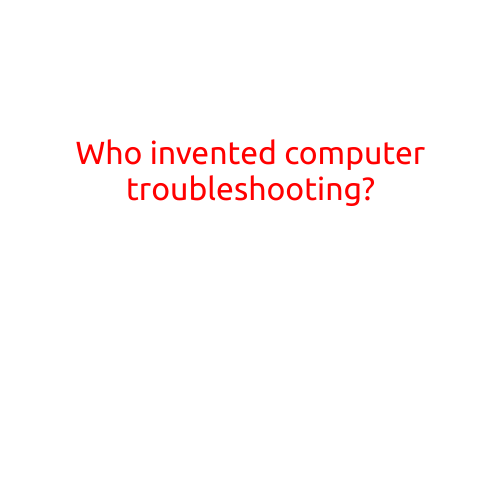
Who Invented Computer Troubleshooting?
In the early days of computer development, troubleshooting was a daunting task. As computers became more complex and widespread, the need for effective troubleshooting methods grew increasingly crucial. While we may not know the exact individual who “invented” computer troubleshooting, we can explore the evolution of troubleshooting techniques and the pioneers who contributed to its development.
The Early Years: Debugging and Trial-and-Error
In the 1940s and 1950s, computers were massive machines that took up entire rooms. Debugging was a manual process that involved manually checking wires, adjusting switches, and recalculating mathematical equations. This labor-intensive process was often time-consuming and prone to human error.
The first computers were developed by pioneers like Alan Turing, John von Neumann, and Kurt Gödel, who laid the foundations for modern computer science. However, it was programmers like Rear Admiral Grace Hopper, who developed the first compiler, and computer enthusiasts like Douglas Engelbart, who developed the first mouse, that began to streamline the troubleshooting process.
The Advent of Diagnostic Tools
In the 1960s and 1970s, the development of diagnostic tools revolutionized computer troubleshooting. The first diagnostic programs, such as IBM’s System/360, were designed to identify and isolate problems. This allowed technicians to quickly identify and fix issues, reducing downtime and increasing efficiency.
The introduction of microprocessors in the 1970s further accelerated the development of troubleshooting techniques. Engineers like Steve Wozniak and Steve Jobs, co-founders of Apple, were among the first to incorporate diagnostic tools into their designs.
The Rise of Troubleshooting Methodologies
In the 1980s and 1990s, the emergence of structured troubleshooting methodologies transformed the field. The Systems Administration, Networking, and Storage (SANS) Institute developed standard troubleshooting procedures for networking and system administration. This marked a shift from ad-hoc troubleshooting to a more systematic and efficient approach.
Other pioneers, like Microsoft’s David Cutler, who developed the first Windows operating system, and IBM’s Bruce Hershey, who developed the first PC troubleshooting manual, contributed to the development of comprehensive troubleshooting guides.
Modern Troubleshooting: Artificial Intelligence and Automation
In recent years, the rise of artificial intelligence (AI) and automation has transformed the troubleshooting landscape. Tools like Nagios, SolarWinds, and Pandora FMS have enabled real-time monitoring, automated diagnostics, and predictive maintenance.
The development of AI-powered troubleshooting tools, such as IBM’s Watson and Google’s AutoML, has further accelerated the ability to identify and fix issues. These tools can analyze vast amounts of data, identify patterns, and provide recommendations for resolution.
Conclusion
While it is difficult to pinpoint a single individual who “invented” computer troubleshooting, it is clear that the evolution of troubleshooting techniques has been a collaborative effort involving pioneers from various fields. From the early days of manual debugging to the modern era of AI-powered diagnostics, troubleshooting has come a long way.
As technology continues to advance, it is likely that troubleshooting will become even more sophisticated, efficient, and automated. The next generation of troubleshooters will build upon the foundations laid by their predecessors, continuing to push the boundaries of what is possible in the world of computer troubleshooting.





